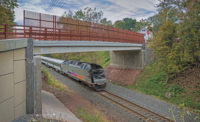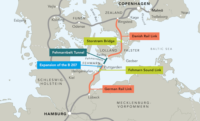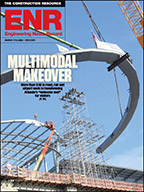Road-and-Rail Bridge Over Mississippi Gets a Physical
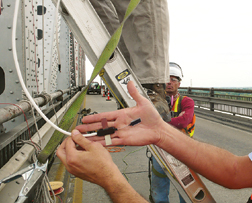 Angelle Bergeron / ENR |
| + click to enlarge |
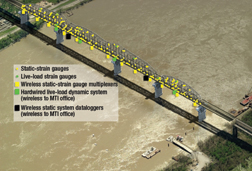 HNTB An 827-sensor stress-monitoring array is being installed on existing steel to establish a baseline before trusses are set between piers in third phase of the bridge-widening project.
|
A joint venture participating in a massive steel-bridge-widening project in New Orleans is establishing a stress baseline for the structure before it is loaded with new steel by installing an 827-sensor monitoring array from end to end.
CTL Group, Skokie, Ill., is installing the sensors on the Huey P. Long Bridge to monitor it for changes during the $489-million third-phase superstructure-erection portion of the $1-billion project. Monitoring is a stipulation of the contract, says Steve Underwood, project manager for contractor MTI, a joint venture of Massman Construction Co., Kansas City; Traylor Bros. Inc., Evansville, Ind., and IHI Inc., New York City.
“When you erect a bridge, those widening trusses, which are stabilized off of the existing trusses, may deflect downward, exerting additional load on those existing trusses,” says Bruce Peterson, senior associate in the New Orleans office of design engineer Modjeski and Masters Inc. “That’s what we don’t want.” The monitors will indicate if an undesirable situation develops so corrective action can be taken, he says.
CTL began installing 777 static and 50 dynamic strain gauges on eye bars and truss members in late January. They will be ready to monitor axial and bending stresses by May, says Tom Weinmann, manager of CTL’s sensors and structural diagnostics team.
Weinmann says the static gauges are vibrating-wire-type gauges. They work like guitar strings, measuring frequency once per second when there is movement. Each consists of a taut wire housed in a stainless-steel cartridge smaller than an ink pen. They are attached to the steel with a series of pin welds and are protected by stainless-steel cover plates.
The 50 dynamic strain gauges work on electrical resistance and take up to 1,000 readings per second. They are protected by butyl rubber and also are pin-welded to the steel. Thomas Industrial Coatings Inc., Pevely, Mo., is removing paint and preparing the sensor locations.
Weinmann says the gauges feed data by wire to 23 multiplexors, or switching systems, located on the bridge, which transmit wirelessly to four hubs on the bridge for transmission to MTI’s trailer. A server hosts and posts the data on the Internet, making it available with password access.
The bridge widening involves modifying the piers to support two new widening trusses that run from pier to pier, parallel to the existing trusses. HNTB Corp., Kansas City, developed a three-dimensional analytical model for MTI that represents ambient load conditions of existing trusses, as well as calculated loads through all stages of installation of the widening trusses, says John Brestin, HNTB’s project manager. “We have models that indicate predicted stresses, live load and allowable margins,” Brestin says. The posted sensor data will be in tabular form, with automated flags, or spikes, to alert key people to unexpected variances from the model Brestin says.
MTI expects to have the full superstructure erection scheme by July. Steel-truss erection will begin in the latter part of 2009. “The idea of getting it [monitoring] done early is to find out what is normal for the bridge, with wind loads, temperature fluctuations and automotive and train traffic,” Peterson says.
Although CTL has done similar work on many bridges, Weinmann says, “We’ve never done anything this dynamic and to this magnitude.”
In addition to installing the monitoring system, CTL will provide long-term maintenance and support of the instrumentation, which will measure and transmit data about the bridge’s structural behavior through completion of the project, scheduled for 2013.


